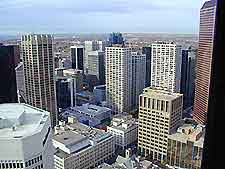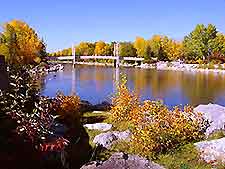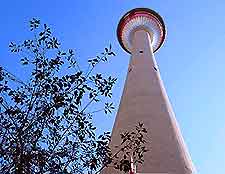Calgary History Facts and Timeline
(Calgary, Alberta, Canada)

Defined by its towering skyscrapers and convenient links to the nearby mountain resorts, Calgary has a long history which will fascinate any visitor. Before the arrival of the first European explorer in 1787, little was known about the indigenous peoples in this area.
It is now believed that pre-Clovis cultures lived here for at least 11,000 years prior to early pioneer David Thompson's arrival. Yet despite the 18th century discovery of these lands, it wasn't until 1875 that the city began to take shape.
The Mounties
In 1875, a tired group of North-West Mounted Police chanced upon the lands which now host the modern city of Calgary. Its two rivers and outlying forests were considered to be the perfect location to build a fort to protect the local population from abuse by US whiskey runners.
The 1883 arrival of the railway led to an influx of cattle ranchers, an event which rapidly increased the population to 4,000 by 1884, the same year that Calgary was officially recognised as a city. In the nearby Rocky Mountains, the
Banff National Park was opened in 1885. Tourists visiting the park have transited Calgary ever since, with many of them now using the first-class Calgary International Airport as a gateway to the region.

The Great Fire
By 1886, Calgary looked like many other Canadian cities, featuring rows of two-storey wooden houses. This reliance on a single building material meant that Calgary was a serious fire hazard. Despite the bravery of local fire-fighters, much of the city was destroyed by the Great Fire of 1886. Residents learned a great lesson from this event and started to use sandstone from the riverbanks to construct homes instead. Subsequently, the so-called Sandstone City was born.
The Calgary Stampede
The city grew steadily from 1886 until 1914, concentrating on ranching and agriculture. Thanks to a well-known cowboy promoter, Guy Weadick, the Calgary Stampede was born in 1912 and still takes place every July, nowadays attracting in excess of one million visitors. This is now one of the biggest rodeo events in the world and certainly one of Canada's most famous festivals. Visitors interested in learning more about the pre-1914 history of Calgary can visit the Heritage Park Historical Village, located by the Glenmore Reservoir.
Oil Discoveries
While 1914 saw the exhaustion of the city's sandstone supply, this year is also remembered in Calgary history for its first oil boom. The boom only lasted for four months, from May to August, when it was abruptly ended by the outbreak of hostilities in WWI. However, it did give a taste of things to come.
In 1947, huge oil reserves were discovered in Leduc, to the north, leading to enormous growth over the coming decades. Calgary was quickly transformed from a low-rise agricultural center into a modern metropolis dominated by skyscrapers and shopping centers.

Modern-Day
The transformation to an international hub is considered to have been completed in 1988, when the city hosted the Winter Olympics. Like much of the world, Calgary suffered during the 1980s recession, leading to huge layoffs in the energy sector. Fortunately, the Games allowed many workers to find alternative employment in construction and tourism.
The event left the legacy of the Canada Olympic Park, a multi-purpose venue with facilities for skiing, snowboarding and mountain biking. Visitors are able to visit the Olympic Hall of Fame and Museum for further insight into the past Calgary Olympics.
 Defined by its towering skyscrapers and convenient links to the nearby mountain resorts, Calgary has a long history which will fascinate any visitor. Before the arrival of the first European explorer in 1787, little was known about the indigenous peoples in this area.
Defined by its towering skyscrapers and convenient links to the nearby mountain resorts, Calgary has a long history which will fascinate any visitor. Before the arrival of the first European explorer in 1787, little was known about the indigenous peoples in this area.
